Content
What is composable commerce?

Time to read: 30 minutes
The consumer is king. This is an undeniable and long-known fact. However, in 2024 and 2025, the consumer is the spoiled king. This is especially true for eCommerce platforms because online shopping isn’t just something people do from time to time. It has become part of our routine, and because of this we expect online shopping to be effortless and enjoyable.
The only way for eCommerce platforms to provide consumers with top-notch shopping routines is to take care of the technical side of their platforms. But there is a trick: Not all technologies allow eCommerce companies and companies that have eCommerce distribution channels to flexibly and timely serve their spoiled consumers.
Ecommerce suffers from a few instrumental problems:
- Slow innovation hinders a business’s ability to nimbly adapt to changing market and consumer demands.
- Difficulties with integrating third-party platforms result in discrepancies within the purchasing lifecycle, leaving users unsatisfied with the overall shopping experience.
- An inability to easily scale on demand and handle increased traffic and transaction pressure on the system prevents businesses from properly serving consumers during peak seasons.
- Poor or outdated user experiences can’t easily be fixed because of inflexible systems.
Now, let’s dive deep into the solution to these problems: composable commerce.
Composable commerce explained
If the concept of composable commerce is new to you, here’s a list of reasons to delve into it:
- Despite being a relatively new concept in eCommerce, composable commerce is here to stay.
- Composable commerce will undoubtedly affect how the ecommerce industry evolves in the coming years.
- The technologies supporting composable commerce are capable of helping your eCommerce platform withstand future technological challenges.
In this and the following sections, we’ll answer these and the other questions:
- What is composable commerce as an approach to ecommerce?
- What are the origins of composable commerce, and how comprehensive is it?
- What business potential and technological value does this approach bring to businesses?
- How do traditional and composable development approaches compare? (Along with real-life examples of short- and long-term results.)
Composable commerce definition
Composable commerce represents the concept of flexibility, according to which businesses rely on a module-based architecture that allows for independent components to seamlessly work together. Each module usually serves a specific function, such as payment processing, inventory management, customer relationship management, or customer engagement, and can be selected and integrated based on the company’s business needs to create a comprehensive composable commerce ecosystem.

This independence means that businesses can easily replace or upgrade individual modules without impacting the entire system, responding in a timely manner to market innovations and customer demands.
What is composable commerce as opposed to traditional e-commerce approaches?
Composable commerce focuses on a pick and choose formula, customization, and adaptability. Businesses can easily integrate various packaged business capabilities (PBCs), such as payment solutions, a content management system, and customer relationship tools from multiple vendors, in a way that truly fits their unique needs and strategic short- and long-term business goals. It’s all about creating a setup that feels right for the specific business and helps them better serve their customers.
In a monolithic setup, businesses often find themselves locked into specific technologies that might not evolve with their needs. This can be frustrating because it means businesses have to stick with outdated tools, which limit growth and responsiveness.
Getting deeper into technological differences: Architectural concepts
In the case of composable eCommerce, businesses rely on a modular architecture that allows for independent components to seamlessly work together. If a new trend appears in the market or an exciting technology pops up, they can easily swap out or add components. This allows them to avoid vendor lock-in and needing to rebuild their entire platform.
Moreover, if there isn’t any ready-made option on the market that meets your specific business needs, a composable commerce architecture allows you to easily add a custom microservice through an API, which will work seamlessly with the entire system. In the same way, you will be able to update your custom microservice at any moment without compromising the platform’s performance.
In contrast, a traditional monolithic eCommerce architecture is a tightly coupled system where all functionalities are intertwined in a single codebase. In this setup, changes to one part of the application can directly affect others, making it difficult to implement updates or introduce new features.
As a result, any modifications typically require extensive testing, may lead to longer development cycles, and hinder a business’s ability to respond quickly to external needs.
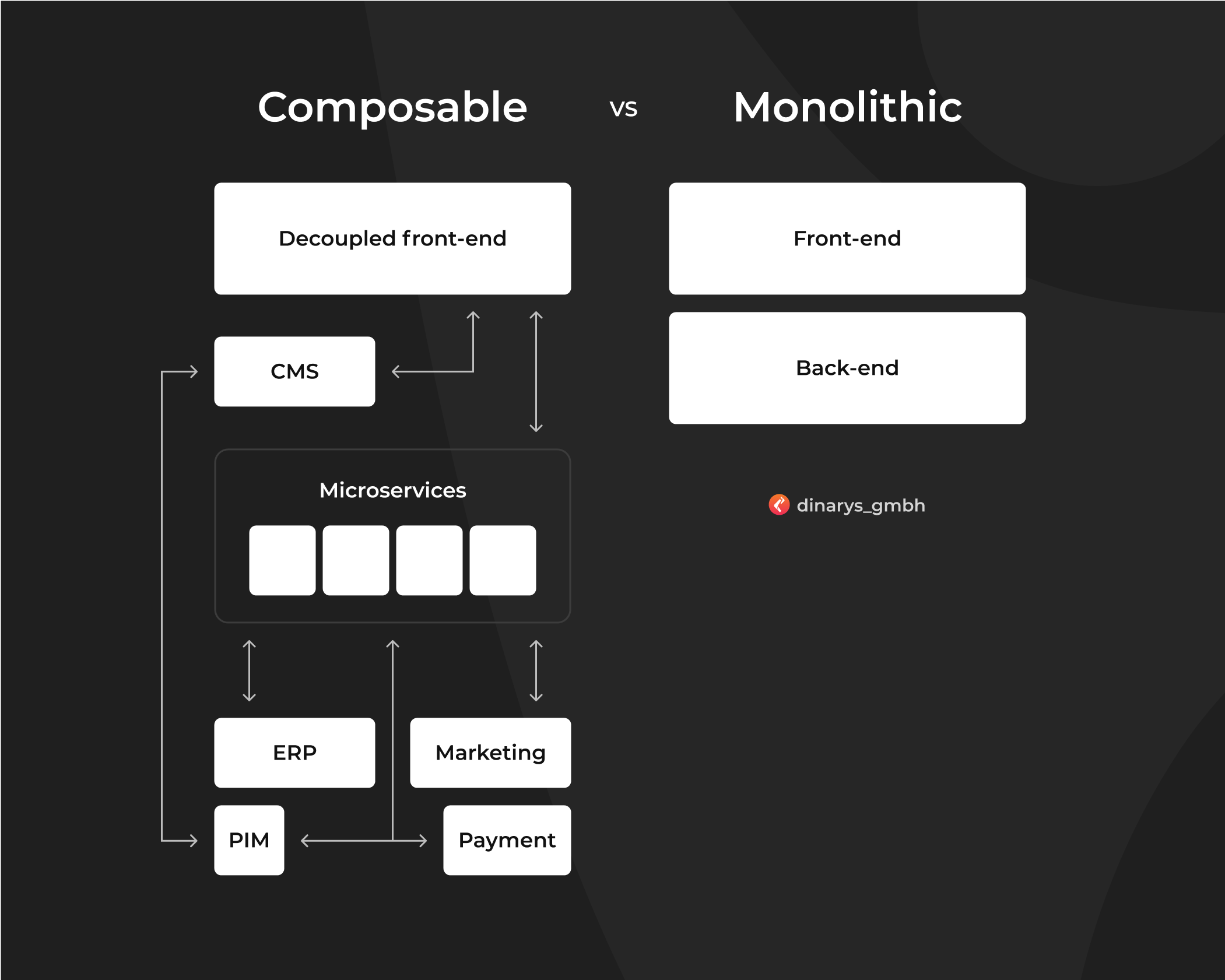
The origins of composable commerce: How Gartner predicted the industry shift
Everything started on June 18, 2020, when Gartner published results of their research in “Composable Commerce Must Be Adopted for the Future of Applications.”
In this publication, Gartner warned that businesses “should prepare for a ‘composable’ approach using packaged business capabilities to move toward future-proof digital commerce experiences.”
Then, in September 2021, Gartner published a report titled “Becoming Composable: A Gartner Trend Insight Report,” which could be considered a turning point in the composable commerce journey. In the report, Gartner introduced the concept of composable digital business and mentioned eCommerce as one of the fastest-developing industries.
What does composable commerce entail?
Composability affects every aspect of your business and solution lifecycle, as shown below:
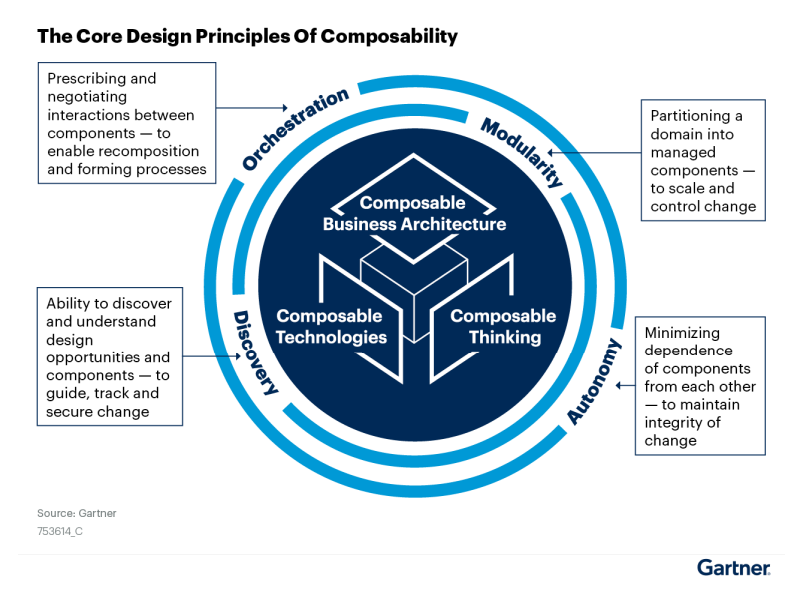
Although composable commerce may seem to be related to the architectural approach, it’s actually about THREE MAIN PRINCIPLES:
- Composable thinking
- Composable business architecture
- Composable technologies
Let’s break down each of them.
Principle #1: Composable thinking
Composable thinking is about adopting a composable mindset, which is about seeing operations as flexible and modular. This mindset allows businesses to quickly adapt and use the best tools to meet changing market needs and improve the customer journey. It may sound easy, but being composable means letting go of a lot of traditional methods of running an eCommerce business:
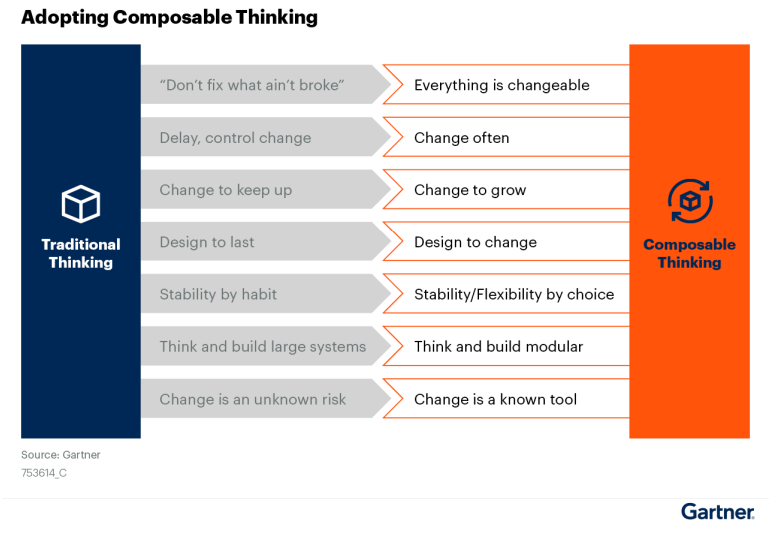
As you can see, at the heart of composable thinking is change in all of its aspects: change in mindset, change in technology, change in one’s attitude towards changing environments, and change as a tool for growth.
Preparing for change is insurance for future business viability.
— Distinguished VP Analysts and Senior Director Analyst at Gartner
Principle #2: Composable business architecture
This principle entails designing the business architecture in a way that gives the R&D team the freedom to implement new features and enhancements without delays and complex technological reconstructions. Overall, a composable business architecture should rely on the following four principles:
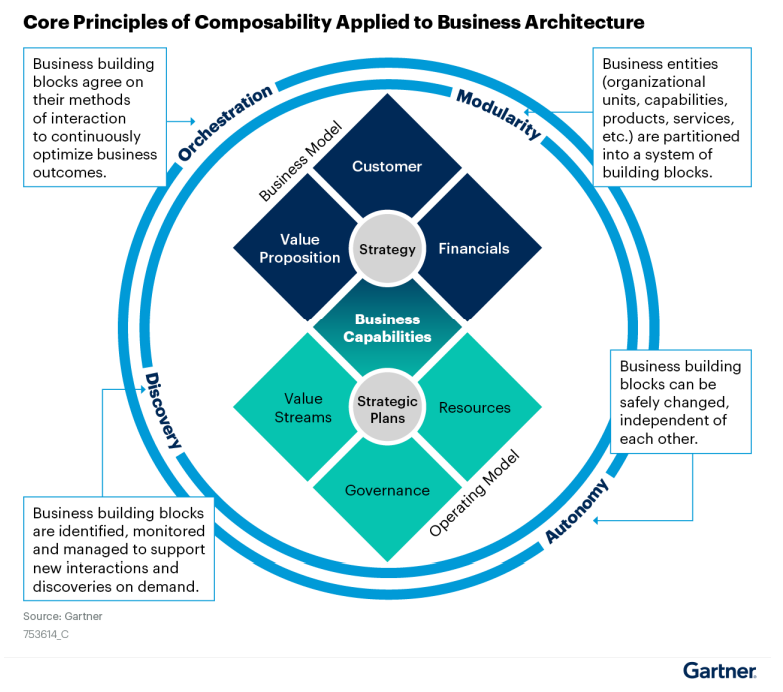
- Orchestration ensures that different parts of the business (a specific function or capability, such as payment processing, CRM, etc.) work well together.
- Modularity lets these parts be separated into independent blocks that can be updated without disrupting anything else.
- Discovery focuses on recognizing and keeping track of different components (or building blocks) within a business to quickly adapt to new opportunities.
- Autonomy means each block can change on its own, making the commerce system more flexible.
Together, these principles help eCommerce businesses create platforms that can easily adjust to market changes, deliver innovative experiences, and encourage new ideas.
Principle #3: Composable technologies
With this principle in mind, businesses have to choose technologies for their eCommerce platforms that will allow for maximum flexibility, customization, and adaptability. Specifically, composable commerce relies on working with the MACH framework when it comes to building, migrating to, or refactoring eCommerce platforms:

How composable commerce works: The MACH framework as an integral component of the eCommerce ecosystem
At the core of composable commerce is the MACH framework, which stands for Microservices, API-first, Cloud-native, and Headless:
- Microservice architecture. This approach breaks down applications into small independent services that perform specific functions. Each service can be developed, deployed, and scaled independently, allowing for greater agility and faster updates.
- API-first. In the composable commerce architecture, every component is designed with an API (Application Programming Interfaces) at its core, facilitating seamless communication between different services. This ensures smooth interactions between systems as well as proper data exchange, making it easy to integrate third-party tools and services as needed.
- Cloud-native platform development. Components are built to operate in cloud environments, exploiting the scalability, reliability, and flexibility that cloud technology offers. This enables businesses to easily scale operations on demand without the constraints of traditional infrastructure.
- Headless architecture. This principle decouples the front end and back end of an eCommerce platform. It allows businesses to create customized user experiences on the front end while using any system for backend processes. Such an approach is sometimes called headless commerce.
As you can see, the MACH framework introduces two alternative solution architectures that challenge the traditional monolithic approach — headless and microservices:

The MACH framework enables businesses to adopt modularity and integration and fuels composable commerce. By choosing the MACH framework, businesses, together with their eCommerce development partners, can select the right components and tools to create a tailored experience that addresses their unique challenges and satisfies customer needs without being tied down by a monolithic system.
Integration ensures these components work together seamlessly, enhancing overall platform performance. Ultimately, adopting MACH principles helps businesses stay flexible and respond quickly, allowing them to succeed in a rapidly changing digital world.
Partner with an ecommerce development company that can work with each type of architecture.
How serious things actually are: Formation of the MACH Alliance
Composable commerce isn’t just a trend that’s been around for a few years — it’s a strategy that will be with us for decades to come due to its powerful potential to overcome monolithic struggles.
To educate the industry about new standards in developing innovative eCommerce solutions as well as to certify companies capable of doing this, organizations such as Amplience, commercetools, Contentstack, EPAM Systems, and Valtech established the MACH Alliance in June 2020.
The mission of the MACH Alliance is to:
...steward the community-led force behind companies transforming to a composable, open tech stack based on MACH principles. We foster a supportive and engaged ecosystem and provide education, standards, and best practices to businesses, enabling businesses to accelerate their digital transformation and achieve long lasting success.
As of November 2024, multiple industry giants have joined the MACH Alliance in various roles. Here are just a few of them:
- Amazon Web Services (AWS) as an Enabler
- Publicis Sapient as a GSI (Global System Integrator)
- Bloomreach as an ISV (Independent Software Vendor)
- Google Cloud as an Enabler
- PayPal as a Supporter
- JP Morgan as a Supporter
The number of MACH Alliance members has reached 113 companies, representing 250,000 employees.
Composable commerce meaning for eCommerce business development
A composable architecture is a game-changer for eCommerce businesses, as it allows companies to gain both short-term and long-term technological and, by extension, business benefits that can positively impact their operations and customer interactions.
In this section, we go into those benefits and compare them to what you get in case of going with traditional monolithic platforms.
Technological benefits of composable Commerce platforms
Short-term benefits:

- QUICKER DEPLOYMENT OF NEW FEATURES. A composable architecture allows businesses to more quickly roll out new features or updates due to modular components. For example, a retail company can implement a new loyalty program using tools like Smile.io without waiting for an entire platform update.
In a monolithic system, the rollout of such a feature could be delayed significantly due to the need for extensive testing and potential rework of existing functionality.
- FLEXIBILITY IN CHOOSING BEST-OF-BREED TECHNOLOGY. Composable commerce enables businesses to choose the best tools for each specific function. For instance, a company might use Stripe for payment processing, Akaneo for product management, and Klaviyo for email marketing.
In a monolithic setup, relying solely on one vendor’s offerings can limit options, forcing businesses to compromise on critical features that could improve performance or customer engagement.
- SEAMLESS INTEGRATION WITH THIRD-PARTY TOOLS. APIs facilitate seamless communication between various services, allowing businesses to easily integrate third-party tools. For instance, if a new marketing automation tool like Mailchimp becomes available, it can be plugged into the existing system without major disruptions.
In contrast, monolithic platforms can struggle with integration, leading to lengthy and complex processes to add new functionality, which can stifle innovation and responsiveness.
- ENHANCED PERFORMANCE WITH OPTIMIZATION TOOLS. Businesses can quickly implement performance-enhancing tools like Cloudflare for CDN services or Redis for caching solutions, optimizing their eCommerce platforms for faster loading times and a smoother user experience.
Monolithic systems may require significant overhauls to improve performance, causing delays in achieving optimal speed and efficiency.
- IMPROVED USER EXPERIENCE THROUGH SPECIALIZED SOLUTIONS. By using specialized frontend solutions such as Storyblok or Contentful, businesses can quickly improve user interfaces. For example, they can implement more intuitive navigation to enhance the shopping experience.
Monolithic platforms often offer limited frontend customization options, making it difficult to adapt the user experience to changing customer preferences.
- REDUCED DEVELOPMENT TIME WITH MODULAR COMPONENTS. The modular nature of composable commerce allows for faster iterations and updates, as each component can be developed and deployed independently. This means a business can roll out changes to its checkout process using a tool like Fastly in weeks instead of months.
In a monolithic system, updates can be slow and cumbersome, leading to missed opportunities to enhance the shopping experience.
Long-term benefits:

- SCALABILITY TO MEET DEMAND DURING PEAK SEASONS. Composable architectures allow businesses to scale specific software components independently. For example, during peak shopping seasons, a retailer can increase the capacity of their payment processing module using Adyen without needing to scale their entire platform.
Monolithic platforms typically require scaling the entire system, which can be inefficient and costly.
- CONTINUOUS INNOVATION BY ADOPTING NEW TECHNOLOGIES. By adopting a composable approach, businesses can continually integrate new technologies and tools as they become available. This ensures that the platform evolves and improves over time, keeping pace with industry advancements.
Monolithic systems often make it difficult to adopt new technologies, as changes can require significant rework, stifling innovation.
- FUTURE-PROOFING AGAINST EVOLVING MARKET TRENDS. Composable commerce allows businesses to adapt to future technology changes, apply modern technology stacks, and meet complex business requirements. For example, an ecommerce company can easily integrate emerging payment solutions like cryptocurrency wallets without overhauling their entire system.
In monolithic setups, adopting new technologies can be complex and disruptive, leading to missed opportunities. Changing the existing system can slow down the release of important features, making it hard for companies to keep up with trends and meet customer needs.
- CUSTOMIZATION TO MEET UNIQUE CUSTOMER NEEDS. Over the long term, businesses can continuously tailor their platforms. For example, they can integrate Algolia for advanced search functionality that evolves with user preferences, enhancing the overall shopping experience.
Monolithic systems often have limited customization options, making it difficult to meet changing customer expectations and demands.
- DATA-DRIVEN DECISIONS THROUGH ADVANCED ANALYTICS. Long-term integration of analytics tools, such as Google Analytics or Mixpanel, allows businesses to gather insights about customer behavior and operational performance, informing strategic decisions.
In a monolithic environment, integrating such tools can be challenging and time-consuming, as they aren’t open to API-based integration with various third-party services.
- ROBUST SECURITY THROUGH THE LATEST SOLUTIONS. As security threats evolve, businesses can integrate the latest security solutions, such as Cloudflare’s security features or Okta for identity management, ensuring customer data remains protected.
In monolithic platforms, implementing new security measures can be a complex process, leaving businesses vulnerable during transitions.
A solid technological base allows eCommerce companies to maximize their investments in composable architecture. This means that as technology improves, businesses can expect to see positive impacts on customer experiences and operations, such as:
Business benefits
Short-term benefits:

- ENHANCED CUSTOMER SATISFACTION FROM QUICK UPDATES. The ability to quickly implement features based on immediate customer feedback leads to higher customer satisfaction. For instance, using tools like Hotjar to gather user feedback can result in quick fixes that improve the shopping experience.
Monolithic platforms may delay these improvements due to the rigidity of their structure.
- INCREASED SALES THROUGH TARGETED FEATURES. By rolling out new features that drive conversions, such as personalized recommendations through Dynamic Yield, businesses can see a direct boost in sales.
In a traditional setup, the inability to adapt swiftly can result in lost sales opportunities during critical shopping periods.
- AGILITY TO RESPOND TO MARKET CHANGES. Composable commerce allows businesses to respond rapidly to market trends. For example, if a new trend for buy-now-pay-later solutions emerges, companies can easily integrate providers like Afterpay or Klarna.
In contrast, monolithic systems often require extensive reconfiguration to accommodate new trends.
- COST EFFICIENCY BY TARGETING ESSENTIAL INVESTMENTS. Lower initial costs are associated with building only the needed components rather than an entire monolithic solution. This can result in immediate savings and more focused investment in essential areas.
Monolithic platforms may incur higher maintenance costs over time due to their complexity.
- BETTER MARKETING ALIGNMENT THROUGH MODERN TOOLS. Integration of modern marketing tools, such as Mailchimp or HubSpot, enables targeted campaigns and promotions, allowing businesses to effectively align their marketing strategies with customer behavior.
Monolithic systems can limit marketing agility, making it harder to take action based on customer data.
Long-term benefits:
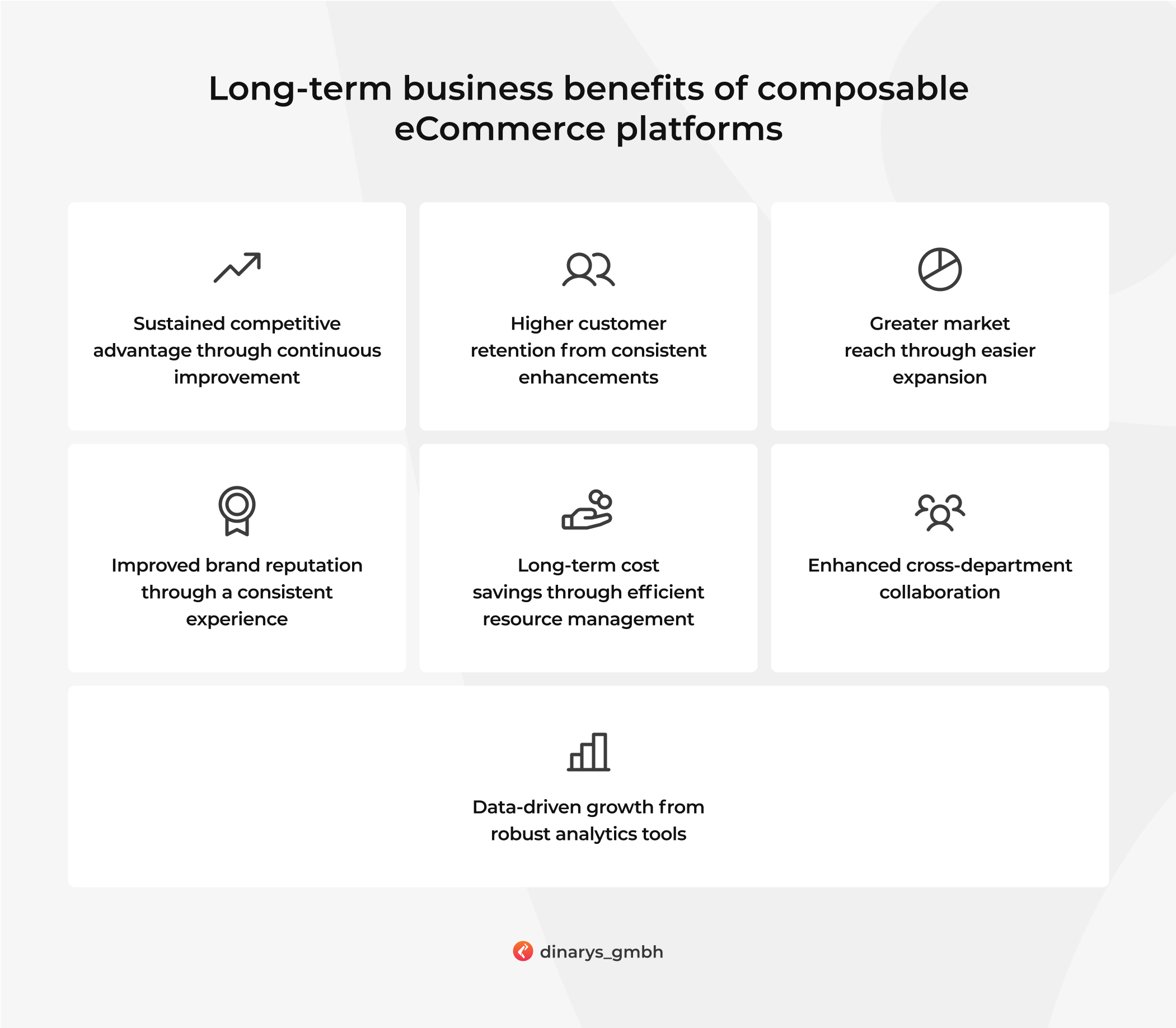
- SUSTAINED COMPETITIVE ADVANTAGE THROUGH CONTINUOUS IMPROVEMENT. The ability to stay ahead of competitors through continuous innovation is crucial. Composable commerce empowers businesses to experiment with new technologies like augmented reality (AR) shopping experiences.
Monolithic systems may struggle to keep pace, leading to competitive disadvantages.
- HIGHER CUSTOMER RETENTION FROM CONSISTENT ENHANCEMENTS. Ongoing improvements to the shopping experience can contribute to increased customer loyalty. For this, businesses can integrate with such platforms as Segment that help to personalize content on eCommerce websites.
Monolithic platforms often hinder the ability to adapt quickly to customer preferences, risking customer churn.
- GREATER MARKET REACH THROUGH EASIER EXPANSION. The flexibility to easily expand into new markets allows businesses to grow their customer base. Composable commerce can facilitate entry into new regions or demographic segments without needing a complete platform redesign.
In contrast, monolithic systems can complicate geographic expansion because they often rely on a single unified codebase that may not easily adapt to the specific needs or regulations of new markets.
- IMPROVED BRAND REPUTATION THROUGH A CONSISTENT EXPERIENCE. Consistently delivering top-notch customer experiences strengthens a brand’s reputation and a company’s market position. As a result, positive consumer experiences lead to word-of-mouth referrals and enhance overall brand loyalty.
Unfortunately, monolithic systems may lead to inconsistent customer experiences because of delays in delivering new features and updates, thus damaging a brand’s reputation.
- LONG-TERM COST SAVINGS THROUGH EFFICIENT RESOURCE MANAGEMENT. Reduced costs for maintenance and updates compared to traditional systems lead to better overall ROI. The flexibility of composable commerce means businesses can manage expenses more effectively and allocate resources where they are needed most.
Monolithic platforms can incur higher long-term costs due to their inherent limitations.
- ENHANCED CROSS-DEPARTMENT COLLABORATION. Many eCommerce platforms integrate with marketing tools, allowing for efficient campaign management and tracking. This allows for improved collaboration across departments (such as marketing and sales) and the creation of more targeted and successful strategies.
Monolithic platforms are limited in their flexibility and data accessibility, which can hinder the effectiveness of marketing and other departments.
- DATA-DRIVEN GROWTH FROM ROBUST ANALYTICS TOOLS. Long-term use of analytics tools like Tableau or Looker to inform strategic decisions allows businesses to align closely with market demands and customer preferences, enabling sustainable and confident business growth.
In monolithic environments, integrating such analytics tools can be challenging, limiting data use.
Use case for building a solution with composable commerce technology: Tradition vs. innovation
To provide a real-life perspective on how composable commerce can transform eCommerce experiences, let’s consider a hypothetical case that contrasts two distinct approaches: a traditional monolithic eCommerce platform and a modern composable commerce solution.
BACKGROUND: Who is the client, and what is their goal?
A mid-sized retail company that aims to enhance its online presence and improve the customer experience by building a new eCommerce platform. They are considering two approaches:
- A traditional monolithic eCommerce platform
- A composable commerce platform using a headless architecture and microservices
OPTION 1: Traditional monolithic eCommerce platform
Design and development process
The company considers selecting a single vendor to provide an all-in-one monolithic solution, such as Magento, or creating a PHP-based eCommerce platform. In both cases, the future platform integrates the front end, back end, and hosting into a cohesive unit, requiring the team to adapt their operations to fit the vendor’s offerings.
Limitations
- Restricted tool and technology selection. The business is confined to the features and tools provided by the vendor. Customization options are limited, forcing compromises that hinder functionality and the user experience.
- Inflexibility. As customer expectations evolve and new industry trends emerge, the company finds it difficult to make necessary updates. Implementing changes like integrating a new payment processor (such as Square or PayPal) or upgrading the user interface can be time-consuming and disruptive.
Long-term consequences
Two years later
- Customer complaints rise as the platform feels outdated and lacks new features
- The development team struggles to implement updates due to the rigid structure of the monolithic system
- Missed sales opportunities and diminished customer satisfaction
Five years later
- The eCommerce landscape has dramatically changed, with new technologies and competitors entering the market
- The company’s inability to adapt quickly results in a significant decline in market share and customer loyalty, ultimately impacting revenue
OPTION 2: Composable eCommerce platform
Design and development process
In this scenario, the company opts for a composable commerce approach, building the platform with a headless architecture and microservices. This allows them to select best-of-breed solutions for each component, such as payment processing, inventory management, and content delivery.
Unlimited flexibility
- Diverse tool selection. With composable commerce, the business can choose from a wide array of innovative technologies and services that best meet their needs. For example, they might integrate Klaviyo for email marketing, Yotpo for customer reviews, or Algolia for enhanced search functionality. This flexibility allows them to stay ahead of trends and continuously enhance the customer experience.
- Seamless API-based integration. When a new payment solution becomes available or a marketing tool gains popularity, the business can easily integrate it into their existing system without major disruptions.
Long-term benefits
Two years later
- The company can swiftly implement new features and enhancements based on customer feedback and market trends
- This responsiveness leads to increased customer satisfaction and loyalty, resulting in higher sales
Five years later
- As the eCommerce environment continues to evolve, the company remains agile and can easily adapt to changes, such as shifting consumer behaviors or emerging technologies
- This adaptability not only strengthens the company’s competitive edge but also drives sustainable growth
The comparison table below outlines the main differences between traditional monolithic eCommerce platforms and composable commerce solutions based on our hypothetical case. It shows how each approach affects tool choices, flexibility, the ability to adapt to changes, customer satisfaction, and long-term revenue.
MONOLITHIC VS. COMPOSABLE COMMERCE
Criteria #1: Tool and technology selection
Traditional monolithic platform: Limited to vendor offerings (e.g., Shopify Plus, Magento)
Composable commerce platform: Unlimited choice of best-of-breed solutions (e.g., Contentful, Stripe, Klaviyo)
Criteria #2: Flexibility in making changes
Traditional monolithic platform: Difficult and disruptive
Composable commerce platform: Easy and seamless integration
Criteria #3: Time to implement changes
Traditional monolithic platform: Slow (months)
Composable commerce platform: Fast (weeks)
Criteria #4: Customer satisfaction
Traditional monolithic platform: Declining due to outdated features
Composable commerce platform: High thanks to continuous improvements
Criteria #5: Market responsiveness
Traditional monolithic platform: Slow to adapt
Composable commerce platform: Quick to pivot based on trends
Criteria #6: Long-term revenue impact
Traditional monolithic platform: Potential decline in market share
Composable commerce platform: Sustained growth and customer loyalty
TAKEAWAYS FROM THIS USE CASE
This use case demonstrates that choosing the right eCommerce platform can significantly impact a business’s success.
Traditional monolithic systems, while offering a unified solution, can limit flexibility and responsiveness, ultimately hindering growth and customer satisfaction. In contrast, a composable commerce approach enables businesses to adapt quickly to market changes, select best-in-class tools, and deliver exceptional customer experiences.
Wrapping up: Where the industry is going
Composable commerce is undoubtedly set to change the future of the eCommerce industry by providing businesses with the flexibility to adapt to changing market demands. The quicker you provide customers with what they want, the faster you can achieve your business goals.
Unfortunately, a monolithic approach can’t help with meeting today’s customer demands let alone tomorrow’s requests for innovation and brand-new experiences. This is why we have composable commerce.
With the adaptability offered by composable commerce, eCommerce businesses can quickly respond to new opportunities and consistently deliver great experiences to their customers. Dinarys can assist you in navigating this shift, ensuring you effectively use composable commerce to meet your customers’ needs and supporting you as your business grows and develops.
FAQ
Composable eCommerce is a way of building eCommerce platforms based on a modular approach that can be easily combined and customized. This allows businesses to select the best tools and services to meet their specific needs, creating a flexible and adaptive composable solution.
The advantages of composable commerce include increased flexibility, the ability to quickly adopt new technologies, improved customer experiences, and easier scalability. Composable commerce enables businesses to customize their eCommerce solutions and quickly respond to market changes and demand.
Composable commerce works according to the MACH framework, which exploits a microservice approach to building applications, API-driven integration between modules and third-party platforms, cloud-native platform development, and a headless architecture.
While traditional platforms often rely on a single monolithic system, composable commerce allows businesses to mix and match components, making it easier to innovate and respond to customer needs.
Let professionals meet your challenge
Our certified specialists will find the most optimal solution for your business.
Related articles
-

Benefits of composable commerce and how they solve critical challenges of eCommerce businesses
Composable Commerce
-
Your mini encyclopedia of composable commerce for 2025: Composable vs headless explained
Composable Commerce
-
Composable commerce trends of 2025: An in-depth look with Dinarys
Composable Commerce


